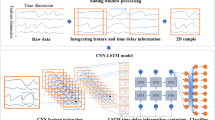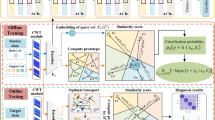Abstract
Recently, modern intelligent fault diagnosis algorithms based on deep learning have been widely used to recognize the health state of rolling bearings. However, the constantly varying load in real industry leads to unsatisfactory diagnosis results. How to make the models effectively diagnose the health state of rolling bearings under varying loads is a key issue. In this paper, an Adaptive Attention Network (AANet) is proposed to resolve the issue. That the interference is introduced by the Multi-scale Convolution Module with wide kernels (MCM) at the head of the AANet is the premise for extending the model to other loads. And the Adaptive Attention Modules (AAMs) embedded in the AANet distinguishe state-related features and unrelated features, which enhances the diagnostic ability of the model across loads. In order to verify the effectiveness of the algorithm, experiments have been performed on a public data set. Experimental results show that the average accuracy of this algorithm achieves 0.976, which can effectively recognize the health state of rolling bearings under varying loads, compared to other algorithms.












Similar content being viewed by others
Data availability
The data that support the findings of this study are openly available at the following URL: https://engineering.case.edu/bearingdatacenter/download-data-file.
Abbreviations
- MCM:
-
Multi-scale Convolutional Module with wide kernels
- CAM:
-
Channel Attention Module
- LAM:
-
Length Attention Module
- AAM:
-
Adaptive Attention Module including channel-first mode, length-first mode, parallel mode and fusion mode
- ResBlock:
-
Residual Block
- ResNet:
-
Residual Network
- AANet:
-
Adaptive attention network
References
Gan M, Wang C (2016) Construction of hierarchical diagnosis network based on deep learning and its application in the fault pattern recognition of rolling element bearings. Mech Syst Signal Process 72:92–104
Lu C, Wang Z, Zhou B (2017) Intelligent fault diagnosis of rolling bearing using hierarchical convolutional network based health state classification. Adv Eng Inform 32:139–151
Guo X, Chen L, Shen C (2016) Hierarchical adaptive deep convolution neural network and its application to bearing fault diagnosis. Measurement 93:490–502
Lu C, Wang ZY, Qin WL et al (2017) Fault diagnosis of rotary machinery components using a stacked de-noising autoencoder-based health state identification. Signal Process 130:377–388
Xia M, Li T, Xu L et al (2017) Fault diagnosis for rotating machinery using multiple sensors and convolutional neural networks. IEEE/ASME Trans Mechatron 23(1):101–110
Zhang Y, Li X, Gao L et al (2018) Imbalanced data fault diagnosis of rotating machinery using synthetic oversampling and feature learning. J Manuf Syst 48:34–50
Zhao R, Yan R, Chen Z et al (2019) Deep learning and its applications to machine health monitoring. Mech Syst Signal Process 115:213–237
Jia F, Lei Y, Lin J et al (2016) Deep neural networks: a promising tool for fault characteristic mining and intelligent diagnosis of rotating machinery with massive data. Mech Syst Signal Process 72:303–315
Zhang W, Peng G, Li C et al (2017) A new deep learning model for fault diagnosis with good anti-noise and domain adaptation ability on raw vibration signals. Sensors 17(2):425
Liu H, Zhou J, Xu Y et al (2018) Unsupervised fault diagnosis of rolling bearings using a deep neural network based on generative adversarial networks. Neurocomputing 315:412–424
Zhang W, Li C, Peng G et al (2018) A deep convolutional neural network with new training methods for bearing fault diagnosis under noisy environment and different working load. Mech Syst Signal Process 100:439–453
Liu H, Yao D, Yang J et al (2019) Lightweight convolutional neural network and its application in rolling bearing fault diagnosis under variable working conditions. Sensors 19(22):4827
Chen T, Wang Z, Yang X et al (2019) A deep capsule neural network with stochastic delta rule for bearing fault diagnosis on raw vibration signals. Measurement 148:106857
Tao H, Wang P, Chen Y et al (2020) An unsupervised fault diagnosis method for rolling bearing using STFT and generative neural networks. J Franklin Inst 357(11):7286–7307
Du Y, Wang A, Wang S et al (2020) Fault diagnosis under variable working conditions based on STFT and transfer deep residual network. Shock and Vibration 2020:1–18
Liang P, Deng C, Wu J et al (2020) Intelligent fault diagnosis of rotating machinery via wavelet transform, generative adversarial nets and convolutional neural network. Measurement 159:107768
Wang Y, Ning D, Feng S (2020) A novel capsule network based on wide convolution and multi-scale convolution for fault diagnosis. Appl Sci 10(10):3659
Jin T, Yan C, Chen C et al (2021) Light neural network with fewer parameters based on CNN for fault diagnosis of rotating machinery. Measurement 181:109639
Chen CC, Liu Z, Yang G et al (2020) An improved fault diagnosis using 1D-convolutional neural network model. Electronics 10(1):59
He K, Zhang X, Ren S et al (2016) Deep residual learning for image recognition. In: Proceedings of the IEEE conference on computer vision and pattern recognition, pp. 770–778
Vincent P, Larochelle H, Bengio Y et al (2008) Extracting and composing robust features with denoising autoencoders. In: Proceedings of the 25th international conference on machine learning, pp. 1096–1103
Fu J, Liu J, Tian H et al (2019) Dual attention network for scene segmentation. In: Proceedings of the IEEE conference on computer vision and pattern recognition, pp. 3146–3154
Jiang JR, Lee JE, Zeng YM (2020) Time series multiple channel convolutional neural network with attention-based long short-term memory for predicting bearing remaining useful life. Sensors 20(1):166
Wang F, Jiang M, Qian C et al (2017) Residual attention network for image classification. In: Proceedings of the IEEE conference on computer vision and pattern recognition, pp. 3156–3164
Xu K, Ba J, Kiros R et al (2015) Show, attend and tell: Neural image caption generation with visual attention. In: International conference on machine learning, pp. 2048–2057
Chen L C, Yang Y, Wang J et al (2016) Attention to scale: Scale-aware semantic image segmentation. In: Proceedings of the IEEE conference on computer vision and pattern recognition, pp. 3640–3649
Jaderberg M, Simonyan K, Zisserman A (2015) Spatial transformer networks. Adv Neural Info Process Syst. 28:2017–2025
Hu J, Shen L, Sun G (2018) Squeeze-and-excitation networks. In: Proceedings of the IEEE conference on computer vision and pattern recognition, pp. 7132–7141.
Roy A G, Navab N, Wachinger C (2018) Concurrent spatial and channel ‘squeeze & excitation’ in fully convolutional networks. In: International conference on medical image computing and computer-assisted intervention. Springer, Cham, pp. 421-429
Woo S, Park J, Lee J Y et al (2018) Cbam: Convolutional block attention module. In: Proceedings of the European conference on computer vision (ECCV), pp. 3–19
Li X, Wang W, Hu X et al (2019) Selective kernel networks. In: Proceedings of the IEEE conference on computer vision and pattern recognition, pp. 510–519
Cao Y, Xu J, Lin S et al (2019) Gcnet: Non-local networks meet squeeze-excitation networks and beyond. In: Proceedings of the IEEE international conference on computer vision workshops, pp. 1971–1980.
Wang H, Liu Z, Peng D et al (2019) Understanding and learning discriminant features based on multiattention 1DCNN for wheelset bearing fault diagnosis. IEEE Trans Industr Inf 16(9):5735–5745
Zhang W, Yang D, Wang H et al (2019) AESGRU: an attention-based temporal correlation approach for end-to-end machine health perception. IEEE Access 7:141487–141497
Li X, Zhang W, Ding Q (2019) Understanding and improving deep learning-based rolling bearing fault diagnosis with attention mechanism. Signal Process 161:136–154
Jin G, Zhu T, Akram MW et al (2020) An adaptive anti-noise neural network for bearing fault diagnosis under noise and varying load conditions. IEEE Access 8:74793–74807
Chollet F (2017) Xception: Deep learning with depthwise separable convolutions. In: Proceedings of the IEEE conference on computer vision and pattern recognition, pp. 1251–1258
Howard A G, Zhu M, Chen B, et al. Mobilenets: efficient convolutional neural networks for mobile vision applications. arXiv preprint arXiv:1704.04861, 2017.
Chen S, Liu Y, Gao X et al (2018) Mobilefacenets: Efficient cnns for accurate real-time face verification on mobile device. In: Chinese conference on biometric recognition. Springer, Cham, 428–438.
Ioffe S, Szegedy C. Batch normalization: Accelerating deep network training by reducing internal covariate shiftarXiv preprint arXiv:1502.03167, 2015.
Ruder S. An overview of gradient descent optimization algorithms arXiv preprint arXiv:1609.04747, 2016.
Sutskever I, Martens J, Dahl G et al (2013) On the importance of initialization and momentum in deep learning. In: International conference on machine learning, pp 1139–1147.
Smith WA, Randall RB (2015) Rolling element bearing diagnostics using the case Western reserve university data: a benchmark study. Mech Syst Signal Process 64:100–131
Maaten L, Hinton G (2008) Visualizing data using t-SNE. J Mach Learn Res 9:2579–2605
Acknowledgements
This work was supported by the Strategic Priority Research Program of the Chinese Academy of Sciences (Grant No. XDC04000000), the National Natural Science Foundation of China (Grant No. 61703393), the Natural Science Foundation of Liaoning Province (Grant No. 2019-MS-343 and No. 20180520008), the Liao-Ning Revitalization Talents Program (Grant No. XLYC2002055) and the K.C.Wong Education Foundation.
Author information
Authors and Affiliations
Corresponding author
Ethics declarations
Conflict of interest
The Authors listed in this article declare that they have no conflict of interest.
Ethical approval
This article does not contain any studies with human participants or animals performed by any of the authors.
Additional information
Publisher's Note
Springer Nature remains neutral with regard to jurisdictional claims in published maps and institutional affiliations.
Rights and permissions
Springer Nature or its licensor (e.g. a society or other partner) holds exclusive rights to this article under a publishing agreement with the author(s) or other rightsholder(s); author self-archiving of the accepted manuscript version of this article is solely governed by the terms of such publishing agreement and applicable law.
About this article
Cite this article
Sun, S., Gao, J., Wang, W. et al. AANet: adaptive attention network for rolling bearing fault diagnosis under varying loads. Int. J. Mach. Learn. & Cyber. 14, 3227–3241 (2023). https://doi.org/10.1007/s13042-023-01830-9
Received:
Accepted:
Published:
Issue Date:
DOI: https://doi.org/10.1007/s13042-023-01830-9




